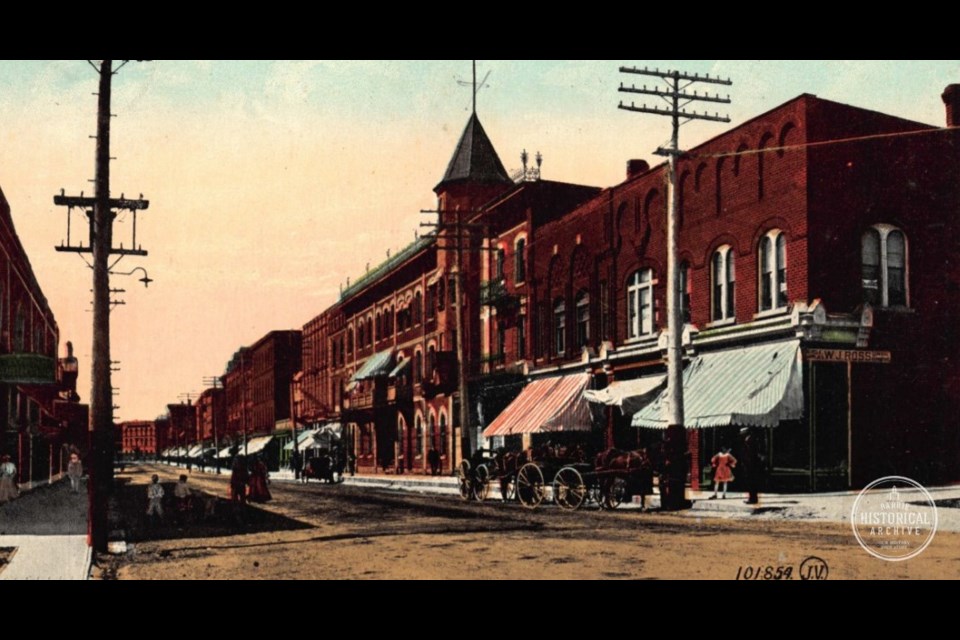Remember that time when the accused went free and his lawyer was found guilty by a court of public opinion?
It all began in early 1913 when David Waisberg, sometimes referred to as Daniel Waisberg, breezed into town and opened his “high-class ladies and gentlemen’s clothing and dry goods store” at 106 Dunlop St. E., one door west of the original Queen’s Hotel.
Just arrived from Toronto, David Waisberg offered the small-town shoppers city fashions at affordable prices. It soon became apparent that Mr. Waisberg was operating more of a bargain shop than a fancy goods emporium.
By August, the Waisberg shop had jumped the Queen’s Hotel and had relocated to a venue located one door east of the hotel. The inventory was by then largely bankrupt stock and fire sale goods brought in from Toronto.
In September of the following year, Mr. Waisberg purchased property on the southwest corner of Mary and Elizabeth streets, where an old brewery cold storage house stood. He had the building demolished and proceeded to have a double store built with apartments above.
Meanwhile, Waisberg fashioned his brand as the biggest thing in deals north of the city. November saw a full-page ad in the Northern Advance proclaiming a “slaughter” of a sale with “prices wrecked in every line.” The ad included a plea for the immediate hire of 15 new clothes salesmen and sales ladies.
“Follow the crowds to D. Waisberg’s Store,” it proclaimed.
Presumably, they did. Waisberg had offered to pay the return train ticket of any out-of-town shopper who purchased $15 or more from his premises.
One month later, Waisberg moved again. His venue had been purchased by A.J. Tuck, another colourful character in the history of bargain shops in Barrie, and Waisberg relocated to a store within the Queen’s Hotel block.
On a cold night in February 1915, a military sentry keeping watch over the town noticed a small amount of smoke emanating from the rear of the Queen’s Hotel. The alarm was sounded and the fire brigade arrived within minutes.
What was at first believed to be a minor fire quickly turned serious when bright flames suddenly shot out the second-floor windows and ran along the roof. The firefighters sprayed four streams of water onto the blaze, but this seemed to have little impression on the fire.
Only an hour after the alarm was sounded, a great explosion was heard and the entire roof fell in allowing the flames to run free. The old hotel, which was an early style woodframe structure with a veneer of brick, was lost after that.
This was the era of the Great War and soldiers were stationed in town. They did the bulk of the work in the efforts to save lives and to empty stores of their stock. The Waisberg shop was completely destroyed, but most of the stock was saved.
Saved may not be the right word. The Waisberg goods were hurriedly tossed out into the snowy street and exposed to smoke, water and the foot traffic of the fire brigade and others.
Well, if David Waisberg knew how to do anything, it was how to conduct a fire sale. His stock was transferred to his not-quite-complete Elizabeth Street store where he prepared to sell what he advertised as $12,000 worth of damaged goods.
In April 1915, all the fire fuss had died down and Waisberg focused on the grand opening of his brand-new store. Maybe not all of the fuss – insurance details and some bothersome creditors were taking much of the joy out of the happy occasion.
David Waisberg declared bankruptcy in May.
When his creditors came calling, they discovered some unusual business practices on the part of David Waisberg. The result was his arrest on charges of defrauding his creditors and not keeping any kind of accounting books in relation to the first charge.
David Waisberg was housed in the Barrie Jail from early summer until his first day in court in September 1915. He entered a plea of not guilty, elected to be tried before a jury and hired W.A. Boys as his attorney. Mr. Boys would later come to regret this association.
Each week, the Barrie Historical Archive provides BarrieToday readers with a glimpse of the city’s past. This unique column features photos and stories from years gone by and is sure to appeal to the historian in each of us



